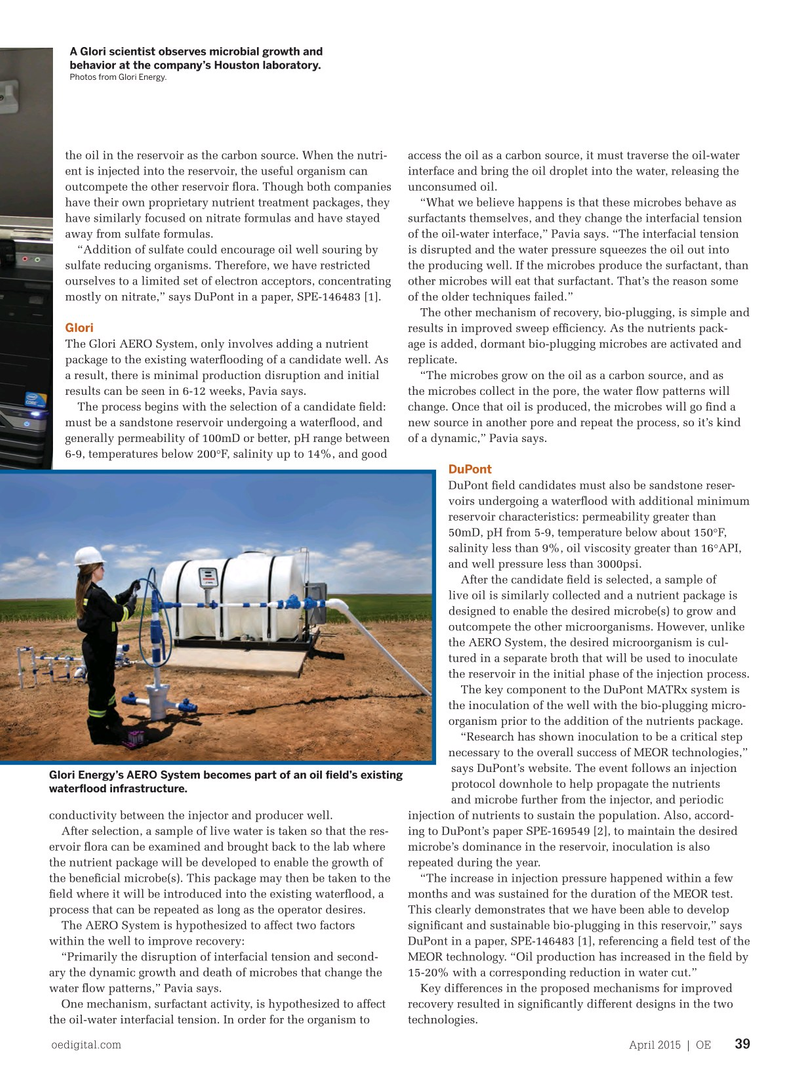
Page 37: of Offshore Engineer Magazine (Apr/May 2015)
Read this page in Pdf, Flash or Html5 edition of Apr/May 2015 Offshore Engineer Magazine
A Glori scientist observes microbial growth and behavior at the company’s Houston laboratory.
Photos from Glori Energy.
the oil in the reservoir as the carbon source. When the nutri- access the oil as a carbon source, it must traverse the oil-water ent is injected into the reservoir, the useful organism can interface and bring the oil droplet into the water, releasing the outcompete the other reservoir fora. Though both companies unconsumed oil. have their own proprietary nutrient treatment packages, they “What we believe happens is that these microbes behave as have similarly focused on nitrate formulas and have stayed surfactants themselves, and they change the interfacial tension away from sulfate formulas. of the oil-water interface,” Pavia says. “The interfacial tension “Addition of sulfate could encourage oil well souring by is disrupted and the water pressure squeezes the oil out into sulfate reducing organisms. Therefore, we have restricted the producing well. If the microbes produce the surfactant, than ourselves to a limited set of electron acceptors, concentrating other microbes will eat that surfactant. That’s the reason some mostly on nitrate,” says DuPont in a paper, SPE-146483 [1]. of the older techniques failed.”
The other mechanism of recovery, bio-plugging, is simple and
Glori results in improved sweep effciency. As the nutrients pack-
The Glori AERO System, only involves adding a nutrient age is added, dormant bio-plugging microbes are activated and package to the existing waterfooding of a candidate well. As replicate. a result, there is minimal production disruption and initial “The microbes grow on the oil as a carbon source, and as results can be seen in 6-12 weeks, Pavia says. the microbes collect in the pore, the water fow patterns will
The process begins with the selection of a candidate feld: change. Once that oil is produced, the microbes will go fnd a must be a sandstone reservoir undergoing a waterfood, and new source in another pore and repeat the process, so it’s kind generally permeability of 100mD or better, pH range between of a dynamic,” Pavia says. 6-9, temperatures below 200°F, salinity up to 14%, and good
DuPont
DuPont feld candidates must also be sandstone reser- voirs undergoing a waterfood with additional minimum reservoir characteristics: permeability greater than 50mD, pH from 5-9, temperature below about 150°F, salinity less than 9%, oil viscosity greater than 16°API, and well pressure less than 3000psi.
After the candidate feld is selected, a sample of live oil is similarly collected and a nutrient package is designed to enable the desired microbe(s) to grow and outcompete the other microorganisms. However, unlike the AERO System, the desired microorganism is cul- tured in a separate broth that will be used to inoculate the reservoir in the initial phase of the injection process.
The key component to the DuPont MATRx system is the inoculation of the well with the bio-plugging micro- organism prior to the addition of the nutrients package. “Research has shown inoculation to be a critical step necessary to the overall success of MEOR technologies,” says DuPont’s website. The event follows an injection
Glori Energy’s AERO System becomes part of an oil feld’s existing protocol downhole to help propagate the nutrients waterfood infrastructure.
and microbe further from the injector, and periodic conductivity between the injector and producer well. injection of nutrients to sustain the population. Also, accord-
After selection, a sample of live water is taken so that the res- ing to DuPont’s paper SPE-169549 [2], to maintain the desired ervoir fora can be examined and brought back to the lab where microbe’s dominance in the reservoir, inoculation is also the nutrient package will be developed to enable the growth of repeated during the year.
the benefcial microbe(s). This package may then be taken to the “The increase in injection pressure happened within a few feld where it will be introduced into the existing waterfood, a months and was sustained for the duration of the MEOR test. process that can be repeated as long as the operator desires. This clearly demonstrates that we have been able to develop
The AERO System is hypothesized to affect two factors signifcant and sustainable bio-plugging in this reservoir,” says within the well to improve recovery: DuPont in a paper, SPE-146483 [1], referencing a feld test of the “Primarily the disruption of interfacial tension and second- MEOR technology. “Oil production has increased in the feld by ary the dynamic growth and death of microbes that change the 15-20% with a corresponding reduction in water cut.” water fow patterns,” Pavia says. Key differences in the proposed mechanisms for improved
One mechanism, surfactant activity, is hypothesized to affect recovery resulted in signifcantly different designs in the two the oil-water interfacial tension. In order for the organism to technologies.
oedigital.com April 2015 | OE 39 038-OE0415_Feat2.Jerry.indd 39 3/23/15 2:28 PM

 36
36

 38
38